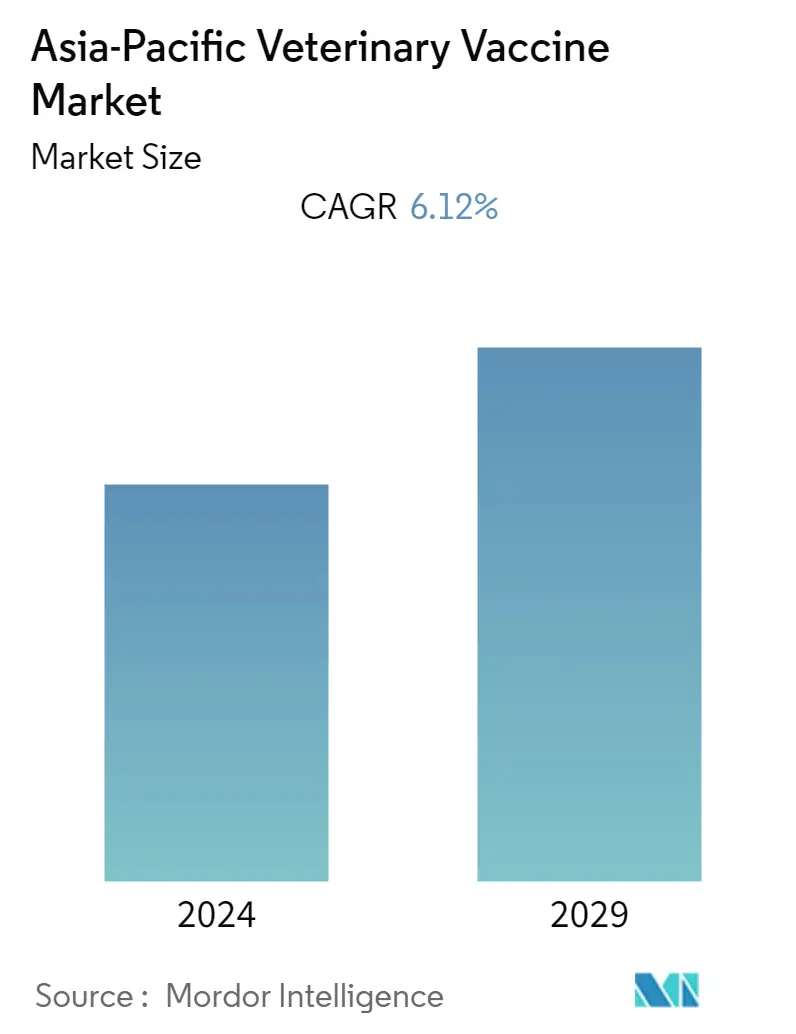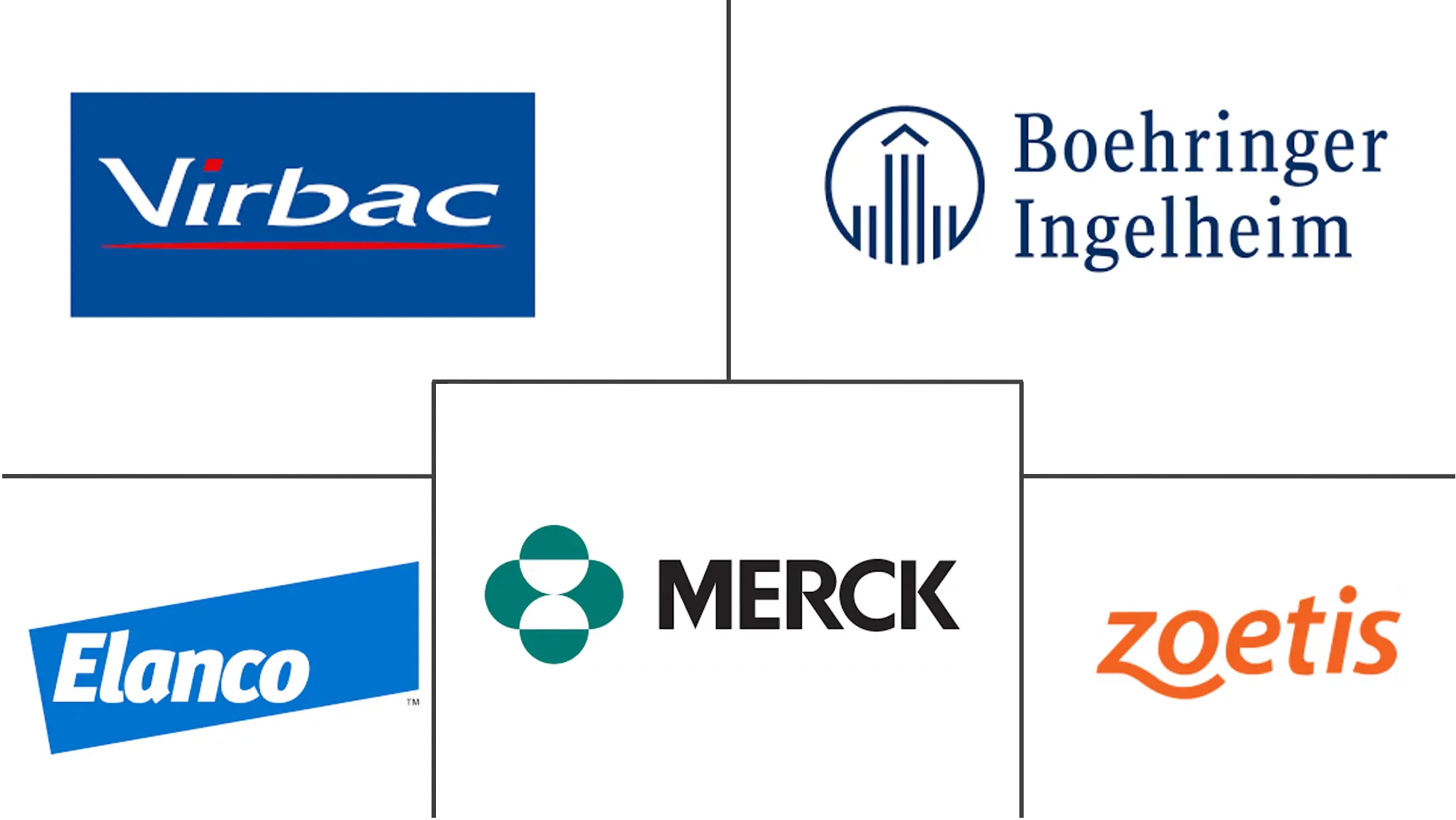Market Size of Asia-Pacific Veterinary Vaccine Industry

| Study Period | 2019 - 2029 |
| Base Year For Estimation | 2023 |
| Forecast Data Period | 2024 - 2029 |
| Historical Data Period | 2019 - 2022 |
| CAGR | 6.12 % |
| Market Concentration | Medium |
Major Players
*Disclaimer: Major Players sorted in no particular order |
APAC Veterinary Vaccine Market Analysis
The Asia-Pacific veterinary vaccine market is expected to witness a CAGR of 6.12% over the forecast period.
COVID-19 has led to increased adoption of pet animals during the pandemic. For instance, as per the data published by the National Institute of Health in March 2021, it has been observed that pet adoption increased in Asian countries during the pandemic, and initial vaccinations on pets were done regularly. Moreover, according to an article published by Frontiers in May 2021, a study was conducted in countries such as Australia, the United States, Canada, New Zealand, the United Kingdom, Singapore, the Philippines, and Malaysia, which showed that during the last five years, the pet adoption rate was the highest during the early pandemic phase. Though the pet adoption rate increased during the pandemic, in several countries, the vaccination of dogs for diseases such as rabies was reduced. For instance, according to an article published by Frontiers in July 2022, a study was conducted in 48 countries in Asia and Africa, which showed that the mass dog vaccination for rabies control was heavily impacted during the early pandemic, and it was carried out as planned in just 5% of surveyed countries. Thus, the veterinary vaccines market was affected significantly as a result of COVID-19. However, as the pandemic has subsided, the pet adoption rate and the vaccination rate have gone back to normal, thus the studied market is expected to have stable growth during the forecast period.
The key factors propelling the growth of this market are the increasing incidences of livestock and zoonotic diseases, veterinary vaccination initiatives taken by various government agencies, and animal associations, as well as by the leading players operating in the Asia-Pacific region. For instance, according to a study published in the Infection Ecology & Epidemiology in September 2021, one of the most dangerous zoonotic diseases in the world is salmonellosis. Salmonella prevalence in animals and risk factors for increased transmission of salmonella spp. from animals to people were evident. Hence, with the emergence of such diseases in animals, the market studied is expected to witness growth over the forecast period.
Moreover, according to an article published by SpringerLink in May 2021, the canine adenovirus (CAV) is said to have two distinct serotypes CAV1 and CAV2. The CAV1 targets the digestive tract tissue and it is the causative agent of infectious canine hepatitis (ICH) (also called Rubarth's disease), a life-threatening disease of puppies, and the CAV2 replicates in respiratory epithelium and is associated with respiratory diseases. A study was conducted on 26 dogs in India which showed the presence of a novel CAV2 strain in dogs that is genetically distinct from other Indian CAV2 strains which are currently circulating in India. The emergence of a such highly infectious novel strain of viruses among the canine population is expected to boost the adoption of vaccines during the forecast period of the study.
Furthermore, according to an article published by Recent Advances in Canine Medicines in October 2021, canine parvovirus-2 (CPV-2) is considered a highly contagious and key entero-pathogen affecting the canine population. In India, the CPV-2a variant of the virus has recently become the most prevailing antigenic type among all variants, and the emergence of such new antigenic variants that differ significantly from the current vaccine strains is a matter of concern for the efficacy of available vaccines. Hence, the emergence of such new virus strains is expected to create more demand for veterinary vaccines.
However, high storage costs for vaccines are expected to hinder the market growth.
APAC Veterinary Vaccine Industry Segmentation
As per the scope of this report, veterinary vaccines are used to immunize domestic and livestock animals. The Asia-Pacific Veterinary Vaccine Market is segmented by Vaccine Type (Livestock Vaccines and Companion Animal Vaccines), Technology (Live Attenuated Vaccines, Inactivated Vaccines, Toxoid Vaccines, Recombinant Vaccines, and Other Technologies), and Geography (China, Japan, India, South Korea, Australia, and Rest of Asia-Pacific). The report offers the value (in USD million) for the above segments.
| By Vaccine Type | ||||||
| ||||||
|
| By Technology | |
| Live Attenuated Vaccines | |
| Inactivated Vaccines | |
| Toxoid Vaccines | |
| Recombinant Vaccines | |
| Other Technologies |
| Geography | |
| China | |
| Japan | |
| India | |
| South Korea | |
| Australia | |
| Rest of Asia-Pacific |
Asia-Pacific Veterinary Vaccine Market Size Summary
The Asia-Pacific veterinary vaccine market is poised for steady growth, driven by the increasing incidence of livestock and zoonotic diseases, alongside proactive vaccination initiatives by government agencies and animal associations. The market experienced disruptions due to COVID-19, which initially impacted pet vaccination rates, but has since stabilized as pet adoption and vaccination rates returned to normal. The emergence of new infectious strains, such as the novel canine adenovirus and the CPV-2a variant, is expected to further stimulate demand for veterinary vaccines. The market is characterized by the development of live attenuated vaccines, which are crucial in controlling infectious diseases among animals, particularly in regions with significant livestock populations like India and Australia.
China's growing trend of pet ownership, particularly among cats and dogs, is a significant factor contributing to the market's expansion. The increasing expenditure on pet care and health products, driven by the rising number of pet owners, is expected to bolster market growth. The Asia-Pacific veterinary vaccine market is moderately consolidated, with major players like Zoetis Inc., Merck & Co. Inc., and Boehringer Ingelheim International GmbH holding substantial market shares. Recent regulatory approvals and developments, such as the launch of new vaccines and diagnostic kits, further underscore the dynamic nature of the market, positioning it for continued growth over the forecast period.
Asia-Pacific Veterinary Vaccine Market Size - Table of Contents
-
1. MARKET DYNAMICS
-
1.1 Market Overview
-
1.2 Market Drivers
-
1.2.1 Rising Burden of Diseases in Animals
-
1.2.2 Initiatives by Various Government Agencies, Animal Associations, and Leading Players
-
-
1.3 Market Restraints
-
1.3.1 High Storage Costs for Vaccines
-
-
1.4 Porter's Five Forces Analysis
-
1.4.1 Threat of New Entrants
-
1.4.2 Bargaining Power of Buyers/Consumers
-
1.4.3 Bargaining Power of Suppliers
-
1.4.4 Threat of Substitute Products
-
1.4.5 Intensity of Competitive Rivalry
-
-
-
2. MARKET SEGMENTATION (Market Size - Value in USD million)
-
2.1 By Vaccine Type
-
2.1.1 Livestock Vaccines
-
2.1.1.1 Bovine Vaccines
-
2.1.1.2 Poultry Vaccines
-
2.1.1.3 Porcine Vaccines
-
2.1.1.4 Other Livestock Vaccines
-
-
2.1.2 Companion Animal Vaccines
-
2.1.2.1 Canine Vaccines
-
2.1.2.2 Feline Vaccines
-
2.1.2.3 Equine Vaccines
-
-
-
2.2 By Technology
-
2.2.1 Live Attenuated Vaccines
-
2.2.2 Inactivated Vaccines
-
2.2.3 Toxoid Vaccines
-
2.2.4 Recombinant Vaccines
-
2.2.5 Other Technologies
-
-
2.3 Geography
-
2.3.1 China
-
2.3.2 Japan
-
2.3.3 India
-
2.3.4 South Korea
-
2.3.5 Australia
-
2.3.6 Rest of Asia-Pacific
-
-
Asia-Pacific Veterinary Vaccine Market Size FAQs
What is the current Asia-Pacific Veterinary Vaccine Market size?
The Asia-Pacific Veterinary Vaccine Market is projected to register a CAGR of 6.12% during the forecast period (2024-2029)
Who are the key players in Asia-Pacific Veterinary Vaccine Market?
Boehringer Ingelheim International GmbH, Zoetis Inc., Merck & Co. Inc., Virbac SA and Elanco are the major companies operating in the Asia-Pacific Veterinary Vaccine Market.

